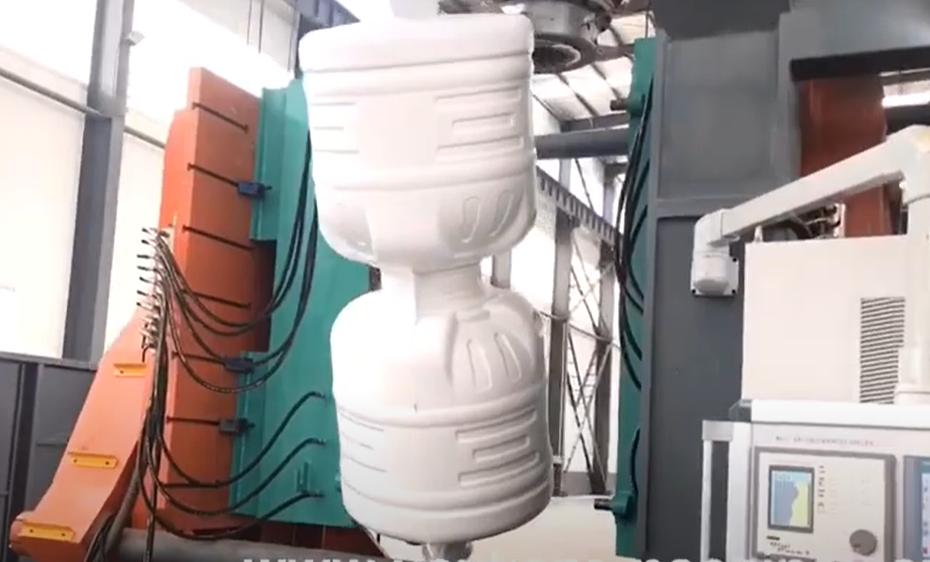In the fast-paced water packaging industry, meeting high demand while maintaining product quality is a top priority for manufacturers. The double-cavity water tank blow molding machine has emerged as a game-changing solution, revolutionizing the production of plastic water tanks. Unlike single-cavity models that create one bucket per cycle, this advanced equipment simultaneously molds two buckets, significantly reducing production time and increasing output—making it a must-have for businesses expanding their water packaging operations.
How Does a Double-Cavity Water Tank Blow Molding Machine Work?
The double-cavity design builds on the core principles of extrusion blow molding but optimizes the process for parallel production. Here’s a simplified breakdown of its key working steps:
1. Plastic Melting & Extrusion: Raw plastic materials (typically high-density polyethylene, HDPE—ideal for water tanks due to its durability and chemical resistance) are fed into the machine’s hopper. The material is then heated and melted in an extruder, forming a continuous tube of molten plastic called a “parison.”
2. Dual-Cavity Mold Closing: The extruded parison is precisely positioned between two identical bucket-shaped molds (the “two cavities”). The molds close tightly around the parison, sealing its bottom and shaping its outer structure.
3. Air Injection & Molding: Compressed air is injected into the sealed parison, forcing the molten plastic to expand and adhere to the inner walls of both molds. This step ensures every detail of the bucket—from its handle grooves to its leak-proof base—is accurately formed.
4. Cooling & Demolding: After molding, the molds are cooled (usually with water or air) to solidify the plastic. Once cooled, the molds open, and the two finished buckets are ejected simultaneously. Post-processing steps (e.g., trimming excess plastic or installing handles) follow, but the core production cycle is already twice as fast as single-cavity machines.
Key Advantages of Choosing a Double-Cavity Machine
For water packaging manufacturers, the double-cavity water tank blow molding machine offers unmatched benefits that directly impact profitability and competitiveness:
– Higher Production Efficiency: The most significant advantage is its ability to produce 80-100% more tanks per hour compared to single-cavity machines. For example, a standard single-cavity machine might make 30-40 tanks/hour, while a double-cavity model can reach 60-80 tanks/hour—critical for meeting peak demand (e.g., summer months or natural disasters).
– Lower Unit Costs: By doubling output without doubling labor or energy input, the machine reduces the cost per bucket. Fixed costs (like electricity and operator wages) are spread across more units, boosting profit margins for manufacturers.
– Consistent Quality: Modern double-cavity machines use computerized controls (PLC systems) to ensure uniform temperature, air pressure, and mold alignment across both cavities. This means every pair of buckets has identical thickness, strength, and dimensions—essential for complying with water packaging safety standards (e.g., FDA or EU food-contact regulations).
– Space-Saving Design: Unlike running two separate single-cavity machines, a single double-cavity unit occupies less floor space while delivering the same (or higher) output. This is a major plus for factories with limited production area.
Factors to Consider When Selecting a Double-Cavity Water Tank Blow Molding Machine
Investing in the right machine requires evaluating factors that align with your production needs:
– Bucket Size Compatibility: Ensure the machine supports the bucket volumes you produce (common sizes for water packaging are 5L, 10L, 15L, and 20L). Some models offer adjustable molds, while others are specialized for specific sizes.
– Automation Level: Semi-automatic machines require manual intervention for tasks like parison trimming, while fully automatic models integrate loading, molding, and demolding—reducing labor needs but increasing upfront cost.
– Energy Efficiency: Look for machines with energy-saving features (e.g., servo motors or insulated extruders). HDPE melting is energy-intensive, so efficient models can lower long-term operating costs.
– After-Sales Support: Choose a supplier that offers timely maintenance, spare parts (e.g., mold components or air valves), and technical training. Downtime in water packaging can lead to lost orders, so reliable support is critical.

Why the Double-Cavity Machine Is Essential for Modern Water Packaging
As global demand for safe, portable water grows—driven by urbanization, population growth, and increased awareness of clean water access—manufacturers need equipment that can keep up. The double-cavity water bucket blow molding machine addresses this need by balancing speed, quality, and cost. It’s not just a piece of machinery; it’s a strategic asset that helps businesses scale, meet customer demands, and stay ahead in a competitive market.
For small to medium-sized water brands looking to expand, or large manufacturers aiming to optimize existing lines, the double-cavity water tank blow molding machine is the smart choice. Its ability to turn raw plastic into high-quality buckets twice as fast ensures that clean water reaches more consumers—efficiently and reliably.
